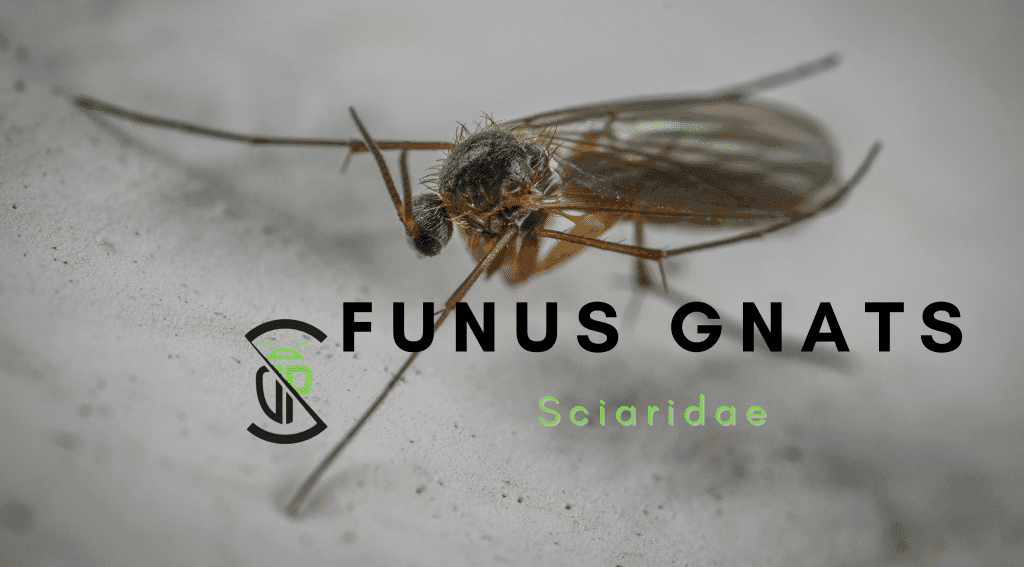Fungus Gnats in South Florida


Fungus gnats are small, mosquito-like flies that are common pests in South Florida, particularly in indoor environments with houseplants or in greenhouses. While they don’t bite humans, they can be a significant nuisance and may damage plants. Dade Pest Solutions specializes in identifying and eliminating fungus gnat infestations to protect your plants and maintain a pest-free environment.
Identification of Fungus Gnats
Physical Characteristics
- Size: Adults are about 1/8 inch (2.5mm) long.
- Color: Grayish-black bodies.
- Wings: Long, delicate wings.
- Larvae: White to clear body with a shiny-black head, about 1/4 inch (5.5mm) when fully grown.
Habitat and Behavior
- Preferred Environment: Moist soil, especially in potted plants, greenhouses, and areas with decaying organic matter.
- Breeding Sites: Females lay eggs in moist soil or organic debris.
- Life Cycle: Consists of four stages – egg, larva, pupa, and adult. The entire cycle takes about 3-4 weeks.
- Activity: Adults are weak fliers often seen running on soil surfaces or resting on leaves.
Risks and Damage
- Plant Damage: Larvae feed on plant roots and lower stem tissues, potentially causing wilting and unhealthy appearance in plants.
- Disease Transmission: Larvae can transmit plant diseases such as Pythium, Phytophthora, and Fusarium.
- Nuisance: While not harmful to humans, large numbers of adults can be a significant annoyance.
Fungus Gnat Control Solutions
At Dade Pest Solutions, we offer comprehensive fungus gnat control services that include:
- Identification: Accurately identifying fungus gnat infestations and breeding sites.
- Treatment: Using a combination of cultural, biological, and chemical control methods tailored to your specific situation.
- Prevention: Implementing strategies to prevent future infestations, such as proper watering practices and soil management.
Prevention Tips
- Avoid overwatering plants; allow soil to dry between waterings.
- Use well-draining potting soil and ensure proper drainage in containers.
- Remove decaying plant material from soil surfaces.
- Use sticky traps to monitor and catch adult gnats.
- Consider using biological controls like Bacillus thuringiensis israelensis (BTI) for larval control.1 Ounce Gnatrol WDG Organic BTI Larvacide For Fungus Gnats.Organic BTI$19.95
FAQ
Q: How do I know if I have a fungus gnat infestation?
A: Look for small, dark flies around plants, on soil surfaces, or near windows. You may also notice thin webs on the soil surface in the early morning.
Q: Are fungus gnats harmful to humans?
A: While fungus gnats don’t bite humans or spread human diseases, they can be a nuisance and may indicate overwatering or poor plant health.
Q: How can I prevent fungus gnats in my houseplants?
A: Avoid overwatering, use well-draining soil, and remove decaying plant material. Consider using sticky traps or biological controls as preventive measures.
Q: Can I use over-the-counter products to control fungus gnats?
A: While some products may provide temporary relief, professional pest control services offer more effective, long-term solutions for persistent fungus gnat problems.
Q: How often should I treat for fungus gnats?
A: Treatment frequency depends on the severity of the infestation and environmental factors. Our experts can provide a customized treatment plan based on your specific situation. For more information or to schedule a free evaluation, contact Dade Pest Solutions today. Our team of experts is dedicated to keeping your home and plants free from fungus gnats and ensuring your peace of mind.
